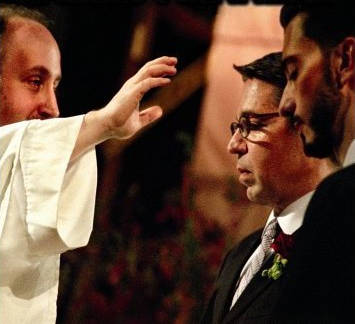A True Italian/American Marriage
A young director meets a couple in love; this is not the first time that a film is born from this kind of encounter. Perhaps it would not even be shown in this context, were it not for the film’s extraordinary point of view and its connection to the Italian/American experience. Director Abigail Honor, an Englishwoman transplanted to Manhattan, has at least two reasons for telling the story: the film’s artistic value as a documentary as well as the cultural value of its content.
Released in 2003, the film has been shown at many film festivals, and its awards include the "Q Cinema Award" for the best documentary film at the sixth annual Fort Worth Lesbian and Gay Film Festival in 2004.
The film was screened last week in the CUNY TV studios as part of the film series “Documented Italians” presented by the John D. Calandra Italian American Institute of Queens College. The film concerns Vincent Maniscalco and Edward DeBonis, a gay Italian/American couple who decide to marry in church according to Catholic rite. The public was invited to participate in a discussion that is still not easy or straightforward. In fact, both Professor Anthony Julian Tamburri, Dean of the Calandra Institute and Joseph Sciorra, Assistant Director of Academic and Cultural Programs emphasized that when the film was released four years ago the time was not yet ripe to publicly tackle these issues. And is now the right time? The debate is now at least open, especially since the film screening was hosted by of one of the most important Italian/American institutions.
Abigail Honor and Professor Peter Savastano of Seaton Hall University and Drew University moderated the discussion after the film and focused on the film’s cultural imperatives for the Italian/American community.
Since the time of its release Saints and Sinners has received mixed reviews. Its main theme touches on the depth of Italian/American culture and its intimate link to Catholic tradition, and suggests the perceptions that Americans have of Italian/Americans and their faith.
Forty-six year old Vinnie and 52 year old Eddie are both of Italian descent, and like many Italian/Americans they were raised with solid Catholic values. For them to wed in a church represents an acknowledgement of their Italian/American upbringing.
“Before meeting Vinnie,” Eddie recalls, “I had gone away from the Catholic Church but then I understood that for him, the sacraments were an important part of his spirituality, and this was my way of reconciling with Catholicism. The Catholic Church may never recognize our union, but we had to fight for it nevertheless.” These are profound words that transcend the Catholic Church’s perception of homosexuality and they reveal the couple’s connection to their Catholic and Italian/American roots.
In reality, the couple was not wed in a Catholic church as no priest would accept their union, but they were married in an Episcopalian church by a gay minister, Raymond LeFebvre. Their union became official when the state of Massachusetts legalized homosexual marriage and they were later re-married.
Abigail Honor recounts how she met the couple: “I got to know Eddie e Vinnie after I put an ad in the Village Voice to find people for a documentary. After a while, I received a call from Eddie and I immediately understood that they were exactly who I was trying to find. They were the right people to bridge the gap between a gay couple, their families, and the communities in which they were raised.”
Honor approaches the themes of the documentary with detachment balanced with profound tenderness. There is no shadow of judgment present in the film; they are presented simply and treated as an ordinary couple.
It was the couple’s normalcy that struck us most, especially as they retold the story of their meeting and the stages that led to marriage, like that of any heterosexual couple. They are very much a conventional couple, and perhaps seem even more so because of their respect for tradition and culture. Written in their own words, their marriage vows speak of their commitment, mutual respect, and the search for recognition of their union.
The preparation of the church where the wedding took place made us reflect on the differences between a typical Italian/American wedding and an Italian one. The accuracy with which the preparations were made was far more Italian/American than Italian.
At the end of the screening, the audience was left with an overarching feeling of purity and simplicity. With subtlety and without brooding, the film also touched on certain prejudices against gay marriage. For example, on the day of the wedding there is the fear of going to hell if one receives the sacrament of Communion from a gay minister.
The director’s talent lies in her ability to suggest different aspects of the theme without favoring one over another. She reminds us that it is also important to reflect on the couples’ smiles and mutual glances on their wedding day when their wedding announcement appears in the “Styles” section of the New York Times. Can the New York Times pronounce their union “official”?
The documentary can be purchased at www.amazon.com.
(Translated by Giulia Prestia, a memeber of i-Italy's Community)


































i-Italy
Facebook
Google+
This work may not be reproduced, in whole or in part, without prior written permission.
Questo lavoro non può essere riprodotto, in tutto o in parte, senza permesso scritto.